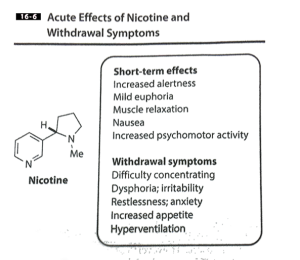Drug addiction is a progressive and often fatal behavioral syndrome characterized by compulsive drug seeking and consumption despite serious negative consequences.
- “The defining feature of addiction is the compulsive, out of control drug use, despite negative consequences.”
- “Addictive drugs induce pleasurable states or relief from distress, thus motivating repeated drug use.”
- “Drugs of abuse are both rewarding and reinforcing. Rewards are stimuli that the brain interprets as intrinsically positive, and reinforcing stimuli are those that increase the probability that behaviors paired with them will be repeated”
- “Repeated use of addictive drugs produces multiple unwanted changes in the brain that may lead to tolerance, sensitization, dependence, and addiction”
- Drugs of abuse cause addiction by inducing a range of molecular and cellular adaptations in several brain reward regions, which are becoming increasingly well known.”
“Drug addiction is a progressive and often fatal behavioral syndrome characterized by compulsive drug seeking and consumption despite serious negative consequences. The drug-centered existence of addicts can cost them their jobs, personal relationships, financial standing, happiness and, in some cases their lives.”
Addicts regularly report that they know that the consequences of their addictions are causing negative consequences in their lives, which may even cost their lives, but they are unable to stop seeking the drug to which they are addicted. They cannot seem to make positive choices to promote their own happiness and survival. “In both animals and humans, roughly 50% of the risk for addiction is genetic, but the specific genes that comprise that risk remain almost completely unknown.”
In reality, not everyone who is exposed to an addictive drug becomes addicted, in fact it is less than 10% of people who have an addictive genetic makeup and who are susceptible to dependence on a particular substance.
Because of the genetic basis for addiction, it seems that there are “holes or missing” neurotransmitters in a person who is built with an addictive personality. The neurotransmitters are the chemicals that make us feel happy, sad, depressed, or not, and it is the chemical communicators that can make us miserable when they are insufficient. This insufficiency causes us to seek substances that will replace them: food, alcohol, marijuana, sex, or the more traditional addictive drugs all produce effects that mimic the missing neurotransmitters.
Researchers are currently seeking to identify the specific neurochemical and anatomic basis of the reward system of the healthy brain and the changes in this circuitry that causes craving for addictive drugs. Once the brain is exposed to this particular neurotransmitter through a substance, the brain changes and craves that substance causing the addiction.
My basic question for the research and political community is why are we spending so much money on preventing access to drugs instead of finding the particular neurotransmitter that is lacking, and replace it? It seems to me that the tail is wagging the dog in this area of society—making sick people become criminals to get what they need—what the rest of us were born with!
To find the proper solution, it is necessary to understand the physiology of addiction. Addictive drugs initially stimulate the reward centers of the brain, to a greater degree than we can produce internally. Addicts like the high that they receive, but is it because they have been without it from their own biology that it seems so much more intense? After using of addictive drugs, the brain circuitry begins to change and we become dependent on the drug to feel “ok”. After months of exposure to a particular drug, an addict develops a tolerance for it and needs more and more of it to get the high that he/she craves.
Scientists have discovered what they call the “conditioned place preference” animals and humans will put themselves in a physical place or situation that has become associated with the acquisition or administration of the drug. (i.e. the side of the box where the lever is located” the neighborhood or house where the drugs are sold. This is a conditioned response that has been unconsciously learned by the addict much like Pavlov’s dogs and the bell.
We have learned a lot about the specific neurotransmitters and the locations of the centers of the brain where addictions manifest. There are regions of the brain that seem to be identifiable in relation to the cluster of reactions such as cellular change and synaptic responses that can be identified so that we can try experiments to see if we can avoid or cure the addiction. Because of this, we know that addictive drugs tend to gravitate to the centers of the brain that are driven by food, water, sex, and other pleasure sensations. Those locations are then corrupted or confiscated by the drugs, so that eventually we want the drug more than we want the other sensations of pleasure and satisfaction. Even if it kills us.
“Repeated exposure to an addictive drug induces profound cellular and molecular changes within neurons of the brain and reward circuitry…..these adaptations gradually alter normal control of motivated behavior, and eventually produce the compulsive and increasingly involuntary drug seeking behavior that characterizes addiction.”
The fact that each addict picks a particular drug that fits his genetic deficiency—It is what he has been craving his whole life and could not find—it feels like an epiphany! In medicine we have a few examples of medication (non-addictive) that provides the same effect. Many people who have struggled with ADD and ADHD, conditions that are treated with amphetamines, understand the feeling of finally feeling normal, after they are started on ADD drugs. This is evidence of the fact that ADD/ADHD is a condition based on a lack of Dopamine conversion into norepinephrine and epinephrine. When the affected patient is given a drug that is what he is missing, he then feels “normal”.
Instead of doctor managed medicine, most patients with this and other conditions try to treat them on their own and they consume stronger, contaminated and addictive drugs to fix the problem. I once had a Young Life Leader who preached that we are all born with a hole in our souls that only God can fill, and I still believe that, however with neurotransmitters there is sometimes, 10% of the population, there is a hole in their brain that only the right neurotransmitter can fill. It is the job of medicine and research to find out how to fill each “hole”, and addiction with illicit illegal drugs will be over.
Which drugs stimulate which Neurotransmitters?

Terms that are relevant to the research discussion are: Agonist and antagonist Cocaine, amphetamines, and methamphetamines, opiates (morphine and heroin and oxycontin).


Source : Neuropharmacology of Neural Systems and Disorders – Chapter 16
We are learning more and more about the physical structure of the brain and the way the chemical/electrical processes of the brain work naturally and how they can be changed by addictive drugs that impact the neurotransmitter and neuromodulator processes involved in the synapses. The research is exciting and important because the cost of addiction is destructive to our society and to our individual health and survival.
This Health cast was written and presented by Dr. Kathy Maupin, M.D., Bio-identical Hormone Replacement Expert and Author, with Brett Newcomb, MA., LPC., Family Counselor, Presenter and Author. www.BioBalanceHealth.com.



